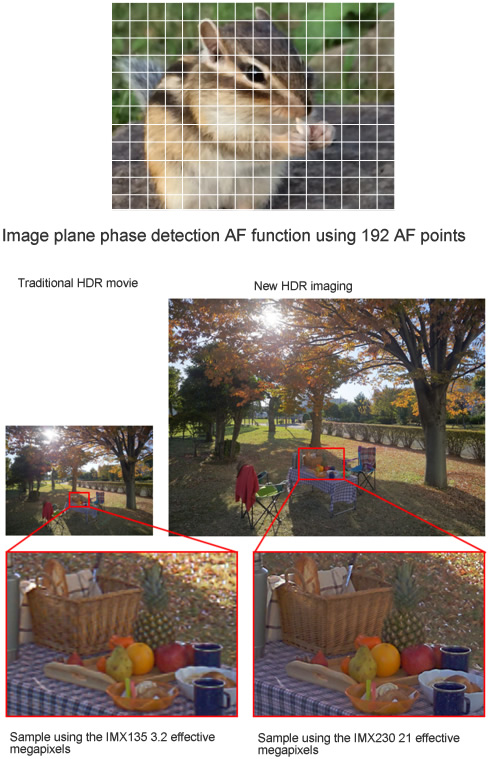
New Sony Exmor RS Stacked CMOS Image Sensor Supports Image Plane Phase Detection Signal Processing Function
Sony has commecrialized the Exmor RS IMX230 for smartphone cameras and other devices requiring sophisticated image-capture functionality. With 21 effective megapixels, this stacked CMOS imaging sensor features compact size and improved functionality. This is the first CMOS image sensor for smartphones to be equipped with an onboard image plane phase detection AF signal processing function to achieve great focus tracking of fast-moving subjects. The High Dynamic Range (HDR) function, which captures both backgrounds and subjects vividly even in high-contrast scenes such as backlit locations, now supports high-resolution still images and 4K video recording.
Rather than the traditional back-illuminated CMOS image sensor's support substrate, the Exmor RS uses a chip consisting of signal processing circuits, on top of which is stacked a pixel section consisting of back-illuminated pixels for an original stacked construction. This kind of stacked CMOS imaging sensorwas first commercialized by Sony in 2012.
The new IMX230 is a type 1/2.4 stacked CMOS image sensor with an improved 21 effective megapixels, and it is also equipped with a newly developed signal processing function. Image plane phase detection AF is a technology used in mirrorless interchangeable-lens cameras, and HDR imaging now supports not only 4K (4096 x 2160) high-resolution videos but also still images. Sony also plans to extend the lineup by adding a 16 effective megapixels stacked CMOS image sensor equipped with image plane phase detection AF and HDR imaging functions by the end of the next fiscal year.
Image plane phase detection AF enables the camera to capture quick-moving subjects and makes high-speed autofocus tracking possible when shooting still images and videos. Dedicated image plane phase detection AF pixels are discretely incorporated into the screen of the image sensor, and the distance to the subject (range) and lens position for focusing are calculated based on the information obtained from these dedicated pixels. Up to 192 AF points can be used. All of this is instantaneously carried out by the stacked CMOS image sensor's internal image processing circuits.

High Dynamic Range (HDR) imaging enables the camera to record still images and videos that reproduce details and rich gradations in the highlights and shadows of high-contrast scenes, such as those found in backlit environments. This is made possible by setting two different exposure conditions and applying the appropriate signal processing to the image information obtained from each condition. Through improved pixel placement and signal processing, this new HDR imaging function is now compatible with both video recording and still image capture. This function is also compatible with 4K (4096 x 2160) high-resolution video recording.
This new CMOS image sensor will ship in April 2015.
| Model | IMX230 | |
|---|---|---|
| Number of effective pixels | 5344 (H) x 4016 (V) 21 megapixels | |
| Image size | Diagonal 7.487mm (Type: 1/2.4) | |
| Unit cell size | 1.12μm (H) x 1.12μm (V) | |
| Frame rate | Full | 24fps |
| Video |
|
|
| Sensitivity (standard value: F5.6) | 78mV | |
| Sensor saturation signal (minimum value) | 330mV | |
| Power supply | Analog | 2.5V |
| Digital | 1.1V | |
| Interface | 1.8V | |
| Key features | Image plane phase detection AF, HDR imaging, white spot correction, NR | |
| Output | MIPI (4 lane) | |
| Image format | Bayer RAW | |






















I am developing a product using IMX230, and have a difficulty on i2c communication between IMX230 and AP. So I need advice for this issue. Question is IMX230 need an external device for CryptoAuthentification as mandatory. if yes, how I get keys for Crypto? do I need any license? Please give any advice for this issue.